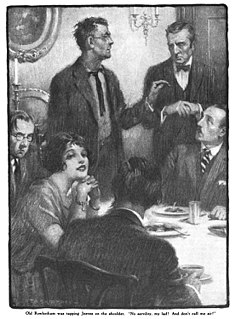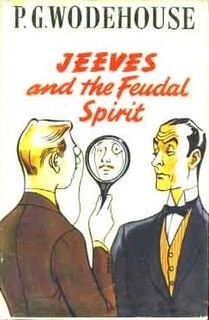Related Research Articles

Reginald Jeeves, usually referred to as just Jeeves, is a fictional character in a series of comedic short stories and novels by English author P. G. Wodehouse. Jeeves is the highly competent valet of a wealthy and idle young Londoner named Bertie Wooster. First appearing in print in 1915, Jeeves continued to feature in Wodehouse's work until his last completed novel Aunts Aren't Gentlemen in 1974, a span of 60 years.
Dahlia Travers is a recurring fictional character in the Jeeves stories of English comic writer P. G. Wodehouse, being best known as Bertie Wooster's bonhomous, red-faced Aunt Dahlia. She is much beloved by her nephew, in contrast with her sister, Bertie's Aunt Agatha.

Roderick Spode, 7th Earl of Sidcup, often known as Spode or Lord Sidcup, is a recurring fictional character in the Jeeves novels of English comic writer P. G. Wodehouse. In the first novel in which he appears, he is an "amateur dictator" and the leader of a fictional fascist group in London called the Saviours of Britain, also known as the Black Shorts. He leaves the group after he inherits his title.

Much Obliged, Jeeves is a comic novel by P. G. Wodehouse, published in the United Kingdom by Barrie & Jenkins, London, and in the United States by Simon & Schuster, Inc., New York under the name Jeeves and the Tie That Binds. Both editions were published on the same day, 15 October 1971, which was Wodehouse's 90th birthday.

My Man Jeeves is a collection of short stories by P. G. Wodehouse, first published in the United Kingdom in May 1919 by George Newnes. Of the eight stories in the collection, half feature the popular characters Jeeves and Bertie Wooster, while the others concern Reggie Pepper, an early prototype for Bertie Wooster.

"Jeeves Takes Charge" is a short story by P. G. Wodehouse, and features the young gentleman Bertie Wooster and his valet Jeeves. The story was published in the Saturday Evening Post in the United States in November 1916, and in The Strand Magazine in the United Kingdom in April 1923. The story was also included in the 1925 collection Carry On, Jeeves.

"Comrade Bingo" is a short story by P. G. Wodehouse, and features the young gentleman Bertie Wooster and his valet Jeeves. The story was published in The Strand Magazine in London in May 1922, and in Cosmopolitan in New York that same month. The story was also included in the 1923 collection The Inimitable Jeeves as two separate chapters, "Comrade Bingo" and "Bingo Has a Bad Goodwood".

Stiff Upper Lip, Jeeves is a novel by P. G. Wodehouse, published in the United States on 22 March 1963 by Simon & Schuster, Inc., New York, and in the United Kingdom on 16 August 1963 by Herbert Jenkins, London. It is the ninth of eleven novels featuring Bertie Wooster and his valet Jeeves.

The Code of the Woosters is a novel by P. G. Wodehouse, first published on 7 October 1938, in the United Kingdom by Herbert Jenkins, London, and in the United States by Doubleday, Doran, New York. It was serialised in The Saturday Evening Post (US) from 16 July to 3 September 1938 and in the London Daily Mail from 14 September to 6 October 1938.

Jeeves and the Feudal Spirit is a comic novel by P. G. Wodehouse, first published in the United Kingdom on 15 October 1954 by Herbert Jenkins, London and in the United States on 23 February 1955 by Simon & Schuster, Inc., New York, under the title Bertie Wooster Sees It Through. It is the seventh novel featuring Bertie Wooster and his valet Jeeves.

Reginald "Reggie" Pepper is a fictional character who appears in seven short stories by English author P. G. Wodehouse. Reggie is a young man-about-town who gets drawn into trouble trying to help his pals. He is considered to be an early prototype for Bertie Wooster, who, along with his valet Jeeves, is one of Wodehouse's most famous creations.
"Jeeves Saves the Cow-Creamer" is the first episode of the second series of the 1990s British comedy television series Jeeves and Wooster. It is also called "The Silver Jug". It first aired in the UK on 14 April 1991 on ITV.
"Aunt Dahlia, Cornelia And Madeline" is the sixth episode of the third series of the 1990s British comedy television series Jeeves and Wooster. It is also called "Comrade Bingo". It first aired on 3 May 1992 on ITV.
"Jeeves and the Greasy Bird" is a short story by English humorist P. G. Wodehouse, and features the young gentleman Bertie Wooster and his valet Jeeves. The story was published in Playboy magazine in the United States in December 1965, and in Argosy magazine in the United Kingdom in January 1967. The story was also included in the 1966 collection Plum Pie.
"Fixing it for Freddie" is a short story by P. G. Wodehouse, and features the young gentleman Bertie Wooster and his valet Jeeves. Originally starring Reggie Pepper, the story was published in The Strand Magazine as "Helping Freddie" in the United Kingdom in September 1911, and in Pictorial Review as "Lines and Business" in the United States in March 1912. The story was later changed to feature Bertie Wooster and Jeeves when it was included in the 1925 collection Carry On, Jeeves.
"Clustering Round Young Bingo" is a short story by P. G. Wodehouse, and features the young gentleman Bertie Wooster and his valet Jeeves. The story was published in the Saturday Evening Post in the United States in February 1925, and in The Strand Magazine in the United Kingdom in April 1925. The story was also included in the 1925 collection Carry On, Jeeves.
"Jeeves and the Song of Songs" is a short story by P. G. Wodehouse, and features the young gentleman Bertie Wooster and his valet Jeeves. The story was published in The Strand Magazine in the United Kingdom in September 1929, and in Cosmopolitan in the United States that same month. The story was also included as the fourth story in the 1930 collection Very Good, Jeeves.
"The Spot of Art" is a short story by P. G. Wodehouse, and features the young gentleman Bertie Wooster and his valet Jeeves. The story was published in The Strand Magazine in the United Kingdom in December 1929, and in Cosmopolitan in the United States that same month, as "Jeeves and the Spot of Art". The story was also included as the sixth story in the 1930 collection Very Good, Jeeves.
"The Love that Purifies" is a short story by P. G. Wodehouse, and features the young gentleman Bertie Wooster and his valet Jeeves. The story was published in The Strand Magazine in the United Kingdom in November 1929, and in Cosmopolitan in the United States that same month, as "Jeeves and the Love that Purifies". The story was also included as the eighth story in the 1930 collection Very Good, Jeeves.
"The Ordeal of Young Tuppy" is a short story by P. G. Wodehouse, and features the young gentleman Bertie Wooster and his valet Jeeves. The story was published in The Strand Magazine in the United Kingdom in April 1930, and in Cosmopolitan in the United States that same month, both as "Tuppy Changes His Mind". The story was also included as the eleventh story in the 1930 collection Very Good, Jeeves.
References
- Notes
- 1 2 Cawthorne (2013), p. 87.
- ↑ Wodehouse (1993) [1959], chapter 4, p. 82
- ↑ Wodehouse, P. G. (May 1913). "Doing Clarence a Bit of Good". Madame Eulalie. Retrieved 12 February 2018.
- ↑ Voorhees, Richard J. (1966). P. G. Wodehouse . New York: Twayne Publishers, Inc. pp. 164–165. ISBN 0805715762.
- ↑ McIlvaine (1990), p. 183, D133.28.
- ↑ Wodehouse, P. G. (April 1914). "Rallying Round Clarence". Madame Eulalie. Retrieved 12 February 2018.
- ↑ McIlvaine (1990), p. 173, D102.3.
- ↑ McIlvaine (1990), p. 190, D148.9.
- ↑ McIlvaine (1990), p. 165, D74.5.
- ↑ McIlvaine (1990), p. 129, B32a.
- ↑ McIlvaine (1990), pp. 33–34, A21b and A22a.
- ↑ Wodehouse (1997), pp. ii–v.
- ↑ Ring, Tony; Jaggard, Geoffrey (1999). Wodehouse in Woostershire. Chippenham: Porpoise Books. p. ix. ISBN 1-870-304-19-5.
- ↑ McIlvaine (1990), pp. 112–113, B1.
- ↑ "Jeeves and Wooster Series 3, Episode 6". British Comedy Guide. Retrieved 10 January 2018.
- Sources
- Cawthorne, Nigel (2013). A Brief Guide to Jeeves and Wooster. London: Constable & Robinson. ISBN 978-1-78033-824-8.
- McIlvaine, Eileen; Sherby, Louise S.; Heineman, James H. (1990). P. G. Wodehouse: A Comprehensive Bibliography and Checklist. New York: James H. Heineman Inc. ISBN 978-0-87008-125-5.
- Wodehouse, P. G. (1993) [1959]. A Few Quick Ones (Reprinted ed.). London: The Guernsey Press Co. Ltd. ISBN 0099819503.